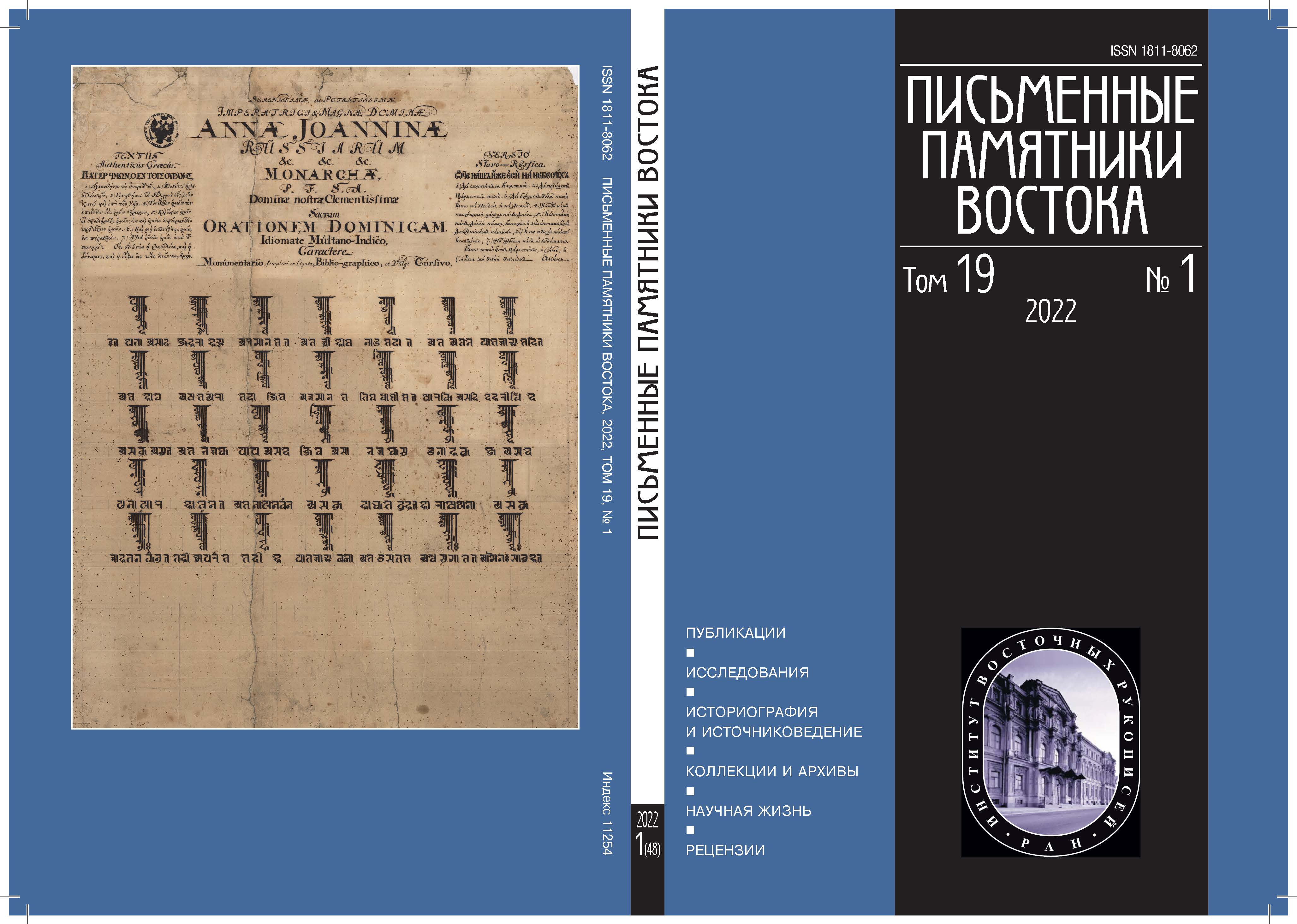The Tangut Manuscript The First [Shamanistic] Ritual from IOM, RAS Collection. Textual Research and Translation
- 作者: Bogdanov K.M.1
-
隶属关系:
- Institute of Oriental Manuscripts, RAS
- 期: 卷 19, 编号 1 (2022)
- 页面: 5-18
- 栏目: Publications
- ##submission.datePublished##: 15.01.2022
- URL: https://journals.eco-vector.com/1811-8062/article/view/100085
- DOI: https://doi.org/10.55512/WMO100085
- ID: 100085
如何引用文章
全文:
详细
The Tangut manuscript “Танг 1621” is recorded evidence of the Tangut shamanistic tradition that existed in the Xixia state, but had originated from the religious beliefs of the Tanguts’ ancestors. This text was discovered among unidentified Tangut texts in the process of cataloguing work. Prior to this this discovery, we came across some indirect references to Tangut shamanism in various sources such as historical documents (The Tangut Codex), ritual or religious text fragments. Most likely, the text in question is an original Tangut text that had originally existed in verbal tradition and was later recorded. Structurally, it consists of 14-syllable verses, including archaisms, unclear metaphors and symbolism. It is a complete manuscript with a title, a short preface, and a logical ending. The title’s translation can be only interpreted tentatively, as it literally means “The Origin of [Religious] Ecstasy (Russian kamlaniye)”. However, I guess that to translate the Tangut word 影 as “[religious] ecstasy” would not be entirely correct in this case, because we find in this text a description of a shamanistic ritual that includes kamlaniye only as its part. The main goal of the rite described here is to defend the world of living beings from the disasters that astral spirits visit on some tribes or ethnic groups for being neglectful of the rules of sacrificial rites or for damaging sacred items. Therefore, this ritual, when it was performed for the first time, was aimed at procuring Heaven’s support for people. On can assume that, once performed, this rite had laid the foundation for a ritual tradition that preserved the wealth and stability of the community that observed it, and later it became the most basic, principal ritual of the state. I can also assume that it was this archetypal rite that emperor Yuanhao performed as he proclaimed himself emperor of the Xixia State. I should add that the above-mentioned linguistic traits pose a serious challenge to the textual research into this source—first of all, to its proper translation. That is why this study is only a preliminary one. The main goal of interpreting this text is to determine the place of the Tangut shamanistic tradition within the context of the long-time scholarly definition of such religious beliefs.
作者简介
Kirill Bogdanov
Institute of Oriental Manuscripts, RAS
编辑信件的主要联系方式.
Email: khmae@list.ru
ORCID iD: 0000-0001-9769-5918
Researcher, the Department of Manuscripts and Documents
俄罗斯联邦, St. Petersburg参考
- Bodde, Derk. “Mify drevnego Kitaia” [Chinese Myths]. In: Mifologiia drevnego mira [Mythology of the Ancient World]. Мoscow: Nauka, 1977 (in Russian).
- Bogoraz, Vladimir.G. Iz arkhiva. Izbrannye trudy V.G. Bogoraza po shamanismu (1934–1936) [Archive. Selected Works of V.G. Bogoraz on Shamanism]. St. Petersburg: St. Petersburg University, 2018 (in Russian).
- Dandekar, Ramachandra. Ot Ved k Induizmu [From Vedas to Hinduism]. Moscow: Vostochnaуa literatura, 2002 (in Russian).
- Eliade, Mircea. Shamanism. Arkhaitcheskie tekhniki ekstaza [Shamanism: Archaic Techniques of Ecstasy]. Moscow: Akademicheskii proekt, 2014 (in Russian).
- Kychanov, Evgeny I. Ocherk istorii tangutskogo gosudarstva [An Essay of the History of the Tangut State]. Moscow: Nauka, 1968 (in Russian).
- Kychanov, Evgeny I. Izmenennyi i zanovo utverzhdennyi kodeks deviza tsarstvovaniia Nebesnoie protsvetanie (1149–1169) [The Revised and Newly Endorsed Code for the “Celestial Prosperity” Era Name, (1149–1169)]. Moscow: Nauka, 1988 (Pamiatniki pis’mennosti Vostoka, LXXI. 1, 2, 3, 4) (in Russian).
- Kychanov, Evgeny I. More znachenii, ustanovlennykh sviatymi [The Sea of Meanings Established by the Saints]. St. Petersburg: St. Petersburg Centre for Oriental Studies Publishers, 1997 (in Russian).
- Kychanov, Evgeny I. Slovar’ Tangutskogo (Si Sia) iazyka [Tangut-Russian-English-Chinese Dictionary]. Kyoto: Kyoto University, 2006 (in Russian).
- Kychanov, Evgeny I. Istoriia tangutskogo gosudarstva [The History of the Tangut State]. St. Petersburg: Faculty of Philology and Arts, 2008 (in Russian).
- Kychanov, Evgeny I. “Novye zakony” tangutskogo gosudarstva (pervaia chetvert’ XIII v.) [The “New Laws” of the Tangut State (the first quarter of the 13th century)]. Moscow: Nauka, 2013 (Pamiatniki pis’mennosti Vostoka, CXL) (in Russian).
- Li Fanwen. A Xixia — Chinese Dictionary. Peking: Publishing House of the Chinese Social Sciences, 2008 (in English).
- Pang, Tatjana. “A ‘Classification’ of the Xibe Shamans”. Shaman, vol. 2, no. 1. Budapest: Molnar & Kelemen Oriental Publishers, 1994, pp. 61–67 (in English).
- Pang, Tatiana. “ ‘Ustav shamanskoi sluzhby manchzhur’ v perevode A.V. Grebenshchikova iz Arkhiva vostokovedov” [The “Shamanistic Ritual Manual of the Manchus” in A.V. Grevenschikov’s Translation]. In: Materialy o mongol’skikh i tiurkskikh narodakh v akademicheskikh sobraniiakh Rossii: Doklady nauchnoi konferentsii [Archival Materials about the Mongolian and Turkic Peoples in the Academic Collections of Russia: Reports of the Scientific Conference]. St. Petersburg: St. Petersburg Centre for Oriental Studies Publishers, 2000, pp. 102–106 (in Russian).
- Revunenkova, Elena V. Shaman i zhrets u batakov Sumatry [The Shaman and the Priest in the Religious System of Sumatra’s Bataks]. Moscow: Nauka, 1973 (Mifologia i verovaniia narodov Vostochnoi i Iuzhnoi Azii [Mythology and Beliefs of the Peoples of East and South Asia]) (in Russian).
- Stein, Rolf. La Civilisation Tibétaine. Paris: Dunot, 1962 (in French).
补充文件







